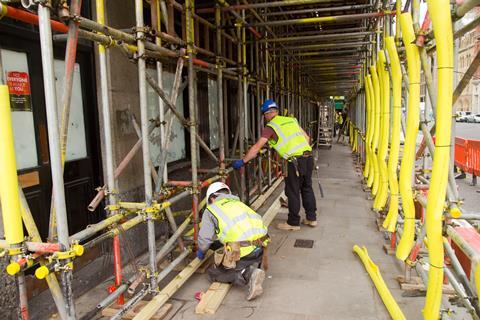Scheme will be rolled out in three phases
Details of the industry’s post-coronavirus rescue plan have been published today.
The Construction Leadership Council’s covid-19 task force has laid out a series of proposals aimed at safeguarding businesses which have already begun to shed jobs as a result of the crisis.

Called the Roadmap to Recovery, the plan has three phases which will be carried out over the next two years.
The first is the restart phase, which will run for the next three months, and aims to increase output, maximise employment and minimise disruption.
The second is the reset phase, which it wants to be implemented between the three and 12 month marks of recovery. Under this phase, the industry will be asked to increase demand, up productivity and strengthen the supply chain.
The final phase, called reinvent, will run for the second year of the recovery and will look at delivering better value and improving collaboration and partnership.
The CLC has laid out detailed plans (attached below) for each stage of all three phases with individual tasks allocated to different groups, organisations and parts of the sector, including the business department, private sector clients and the CITB.
> The CLC’s Roadmap to Recovery: Transformation in a crisis
It has also laid out a timeline for its next steps saying its next major task will be establishing four working groups for infrastructure, housing, repair, maintenance and innovation (RMI) and local, social and commercial infrastructure and construction, which will be up and running by the middle of this month.
The leads for the four working groups are the Infrastructure Client Group for infrastructure, the Home Builders Federation for housing, the Federation of Master Builders for RMI and the Association for Consultancy and Engineering for social and commercial infrastructure and construction.
The CLC structure and operations will be revised to oversee the implementation of the recovery plan by 1 July, while the plan itself will be reviewed and adapted by 1 September to allow the industry to move into its second phase.
The task force was established to provide focus on industry efforts to combat the impact of coronavirus, including developing Site Operating Procedures and addressing shortages of product availability.
Industry Working Groups
| Group | Remit |
|---|---|
InfrastructureLead: Infrastructure Client Group (ICG) Participants: ICE, ACE, CIH, CECA, Build UK, i3P, IPA, CPA, CIC, CITB |
Develop proposals for a future infrastructure strategy, covering new build and RMI, to feed into the National Infrastructure Strategy, embedding key strategic objectives including the adaption of infrastructure post-Covid19, net zero carbon by 2050, levelling up, industry modernisation and digitisation and development of the National Digital Twin
|
HousingLead: Home Builders Federation Participants: BPF, FMB, Build UK, NFB, CIC, MHCLG, BMF, CPA, CITB, IPA |
Develop action plan for restarting and sustaining the housing market and activity in the home building sector, working with MHCLG. Develop proposals for demand side interventions to maintain and accelerate activity in the market at future fiscal events (Budget/Spending Review), including how these can support the use of Modern Methods of Construction (MMC) to increase housing quality, zero carbon and resource efficiency and output and embed building safety considerations |
Domestic RMILead: Federation of Master Builders Participants: CPA, Build UK, ECA, NFB, CITB, CIC BMF, NFRC office of Government Property. |
Develop plans for supporting the RMI sector, enhancing activity, and ensuring RMI in occupied homes can be undertaken safely, and be supported by the construction supply chain. Develop options for demand side initiatives to encourage retrofit to upgrade and improve the energy efficiency and sustainability of homes
|
Local, Social & Commercial ConstructionLead: ACE Participants: NFB, CIH, BPF, Build UK, CPA, ECA, Government Construction Board, CITB, CIC |
Identify the key drivers of demand for social infrastructure and commercial developments, the pipeline of investment, and funding for new projects and RMI. Embed new technologies in the delivery of projects and align these to the requirements of investors. Deliver work to improve building safety and the new system for ensuring safer buildings. Engage LEPs and local authorities on local infrastructure and investment plans, and the use of digital technologies for spatial planning, modelling and for improving the planning system |
Downloads
Roadmap to Recovery
PowerPoint, Size 0.48 mb


























No comments yet